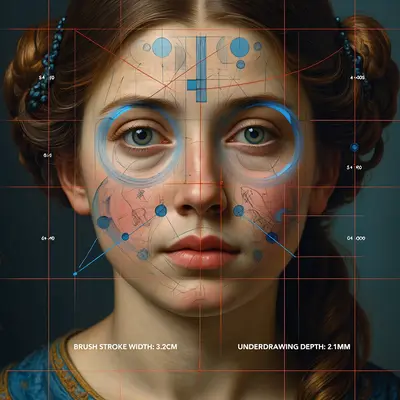When we think of Artificial Intelligence and art in 2025, the dazzling capabilities of AI image generators often steal the spotlight. However, AI's influence on the art world extends far beyond mere creation. Sophisticated AI tools are now being employed for in-depth AI art analysis, meticulous AI art restoration of historical masterpieces, intelligent AI museum curation, and even assisting in complex AI art authentication processes. This post delves into these less-hyped but equally revolutionary applications, showcasing how AI is becoming an indispensable partner for art historians, conservators, curators, and collectors.

1. AI-Powered Art Analysis: Unveiling Hidden Secrets
AI algorithms can analyze artworks with a level of detail and objectivity that complements human expertise, revealing insights previously hidden from view:
- Brushstroke Analysis & Artist Attribution: AI can be trained to recognize the unique patterns and characteristics of an artist's brushstrokes, a "digital fingerprint" that can help attribute unsigned works or identify fakes.
- Pigment & Material Analysis (with Imaging Techniques): Combined with techniques like hyperspectral imaging, AI can analyze the chemical composition of pigments, helping to date artworks, understand an artist's material choices, or identify later alterations.
- Detecting Underdrawings & Pentimenti: AI can process X-ray or infrared images to reveal hidden underdrawings (pentimenti – earlier versions of the painting by the artist), offering insights into the artist's creative process and original intentions.
- Style & Influence Mapping: By analyzing vast databases of artworks, AI can identify stylistic similarities, trace influences between artists, and map the evolution of art movements with greater precision, contributing to AI art history tools.
- Sentiment & Thematic Analysis: AI can attempt to analyze the emotional content or recurring themes within an artist's body of work, providing data-driven perspectives for art historians.
2. AI Art Restoration & Conservation: Breathing Life into the Past
The meticulous work of art restoration is being significantly aided by AI, helping to preserve and reconstruct our cultural heritage:
- Digital Inpainting of Missing Areas: For damaged artworks (e.g., frescoes, paintings with cracks or missing pieces), AI can intelligently predict and fill in the missing parts based on the surrounding context and the artist's style. This is often used to create digital reconstructions or guide physical restoration.
- Color Rejuvenation & Correction: AI can analyze faded or discolored artworks and digitally simulate their original color palettes, providing a non-invasive way to visualize how a piece might have looked centuries ago.
- Virtual Unfolding of Fragile Documents: For ancient scrolls or fragile manuscripts that cannot be physically unrolled, AI combined with CT scanning can digitally "unfold" and reconstruct the text and images within.
- Predictive Conservation: AI can analyze environmental data within museums (humidity, temperature, light exposure) and the material properties of artworks to predict potential degradation, allowing for proactive conservation measures.
These AI art restoration techniques are often used to inform and guide the delicate work of human conservators, providing them with powerful new tools.
3. Intelligent Museum Curation & Visitor Experience with AI
AI is changing how museums and galleries organize their collections and engage with visitors:
- Personalized Tour Guides & Recommendations: Museum apps powered by AI can offer personalized tours based on a visitor's interests, time constraints, or even their emotional response to certain artworks (detected via opt-in facial sentiment analysis or interaction data).
- AI-Driven Exhibit Design: AI can analyze visitor flow, engagement times with different pieces, and thematic connections within a collection to help curators design more engaging and logically structured exhibitions.
- Interactive AI Installations: Some museums are incorporating AI art installations where visitors can interact with or even co-create art with an AI, offering a novel and engaging experience.
- Enhanced Accessibility: AI can generate detailed audio descriptions of artworks for visually impaired visitors or translate exhibit information into multiple languages in real-time.
- Collection Management & Research: AI helps digitize and tag vast museum collections, making them more searchable and accessible for researchers and the public. It can also identify previously unrecognized connections between items in a collection.
AI museum curation aims to create more dynamic, personalized, and insightful experiences for every visitor.
4. AI in Art Authentication: Aiding the Expert Eye
While not a replacement for human expertise, AI art authentication tools are becoming valuable assistants in the complex process of verifying an artwork's genuineness:
- Stylometric Analysis: As mentioned, AI can analyze brushstrokes, color palettes, and compositional patterns to compare a questioned piece against known works by an artist.
- Material Anomaly Detection: AI can help identify anachronistic materials or pigments that wouldn't have been available to an artist at the supposed time of creation.
- Forgery Pattern Recognition: AI can be trained to detect subtle patterns often associated with known forgers or forgery techniques.
- Provenance Research Assistance: AI can sift through vast historical records, auction catalogs, and digital archives to help trace an artwork's ownership history (provenance), which is a key factor in authentication.
It's crucial to note that AI provides supporting evidence in authentication; the final judgment still rests with experienced art historians, connoisseurs, and forensic experts.
The Art World Augmented
In 2025, Artificial Intelligence is proving to be a transformative force in the art world, extending far beyond the realm of generative art. By providing powerful tools for analysis, restoration, curation, and authentication, AI is augmenting the capabilities of art professionals, enriching our understanding of art history, and helping to preserve our shared cultural heritage for future generations. This synergy between human expertise and artificial intelligence promises an even more vibrant and insightful future for art.
What application of AI in the broader art world do you find most exciting? Share your thoughts below!
